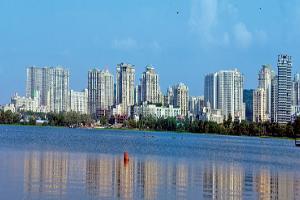Architect Kaiwan Mehta is a visual culture theorist who has critiqued the city via how its buildings have evolved; here he explores how the city's design language has shaped our relationships with each other

In the early 1990s, emerged the suburbs known as Hiranandani Powai - an architecture that built homes for the new yuppy migrant, coming for a job in call centres or corprorate banks. Pic /Rane Ashish
 Every city has a specific nature and character and we all talk about it – but where is it that a city gets its specific attitude and mannerisms? All cities are defined by specific historical moments, and even though they all live through similar histories, certain events define certain cities more specifically – Delhi, for example, is defined by its Mughal history, architecture, and planning, after which the influential moment has been the Lutyen's intervention and move towards a free nation, and that too partitioned! Whereas Bombay and Calcutta have been essentially cities of the 19th century; Bombay was defined by industrialisation and the establishment of the first railway lines in Asia, here in the mid-19th century, after which the next defining moment has been in the 1990s. The last 40 years have redefined Bombay into Mumbai – the city of trade and business, internationalism and cosmopolitanism shifted towards a new notion of what it means to be urban and Indian, it's public and private life both changed.'
Every city has a specific nature and character and we all talk about it – but where is it that a city gets its specific attitude and mannerisms? All cities are defined by specific historical moments, and even though they all live through similar histories, certain events define certain cities more specifically – Delhi, for example, is defined by its Mughal history, architecture, and planning, after which the influential moment has been the Lutyen's intervention and move towards a free nation, and that too partitioned! Whereas Bombay and Calcutta have been essentially cities of the 19th century; Bombay was defined by industrialisation and the establishment of the first railway lines in Asia, here in the mid-19th century, after which the next defining moment has been in the 1990s. The last 40 years have redefined Bombay into Mumbai – the city of trade and business, internationalism and cosmopolitanism shifted towards a new notion of what it means to be urban and Indian, it's public and private life both changed.'
ADVERTISEMENT
The mills shut down in the 1980s and in the next 10 years, the land geography of Mumbai was shifting; 1992-93 saw one of the worst riots in the city's history following the demolition of Babri Masjid and the claim over praying in public space through the Maha-aarti campaigns, followed by the first of the serial bomb blasts in March 1993. These cumulative narrative of events finally saw its pitch in the renaming of the city to an imagined regional past – calling it Mumbai, rather than the more cosmopolitan memory existing within Bombay. Mumbai, Bombay, Bambai, are all names of a city that has hosted and housed tongues and hands not only from all over the Indian sub-continent, but all over the world. The last 40 years have seen a move towards rewriting the history of the city, as well as writing a new memory. These events no doubt are simultaneous with the rise of the Heritage Conservation movement of the city, while mill lands became mall enclaves and rampant slum demolitions cleared lands for call centres and gated housing communities. There was even a policy for clearing out old memories – it was called Slum Redevelopment, where many different kinds of old housing types were declared slums and demolished to give way to new lifestyles and new aspirations. Change is never a problem, cities change all the time, but the brutality of change – physical as well as psychological, is the problem.'
Existing parts of the city were crumbling, and while one fought to preserve their fabric, the crumbling city gave way to a new architecture of brashness, unconcerned with life but most devoted to firing fantasies of global lifestyles. Amid this emerged the suburbs today known as Hiranandani Powai – an architecture that built homes for the new yuppy migrant, coming for a job in call centres or corprorate banks. As we cleared slums, cursing working-class migrants for 'making a mess of the city', the corporate salaried migrant with a credit card and spending power was welcomed with more and more 'castles in the sky'. A kind of cinematic dreamworld architecture became the norm of the day – we shifted from Amitabh Bachchan singing on a Bombay Central railway platform to Govinda singing at the iconic gateway to Powai's Hiranandani Gardens. In debates over the shift towards an architecture of glass buildings, what we forgot to debate and did not realise was how changing neighbourhoods and new kinds of housing designs were changing our relationships with each other, as well as the city. The sanitised, security protected, air-conditioned mall was preferred to walking by the sea or haggling for space in the regular bazaars. Housing enclaves with five and seven rounds of security, and walled gardens, and private temples were more attractive than watching your neighbours and passersby from your balcony, calling out to your playing kids in a colony or moholla. The city's fabric changed, with its investment in an architecture that denied memory, and asked for fantasy domes and twisting glass containers.
Architects got more occupied in designing interiors – as the insides of spaces became more fragile and ready to change every few months; or those who could afford invested in the architecture of vacation homes coming up in Lonavala and Khandala to the Alibaug. So we more and more disinvested in the city – whether we focused on the interiors or islands of luxury and indulgence outside the city – we withdrew our human and cultural investment in the city; and this we tried to make up for by making flyovers, and now coastal roads or wiping out totally a part of the city in the aspiration and promise of a global but religious enclave of high-rises, like in Bhendi Bazaar.
The conservation movement often focused too much on preservation, veering towards nostalgia, rather than arguing for a careful pathway of change and responsible planning. Planners withdrew from drawing out larger city visions, and began to focus more on interventions. New Bombay got planned and built but never integrated into the existing city. However, in the last decade or so, one is again seeing the emergence of an investment in the city through architecture, however small the intervention maybe – as architecture has to always think beyond its own boundaries and building limits although it might be physically defined by it. In 2016 when Rahul Mehrotra, Ranjit Hoskote, and I curated the national exhibition State of Architecure: Practices and Processes in India – a first time documentation and analysis of architecture in India since Independence on such a large scale, with about hundred contributing speakers at the exhibition – it was the city of Bombay/Mumbai that hosted national debates on the public role of architects, and asking for a recovery of the architect as a public figure rather than a lifestyle designer. This was followed in two years by another national exhibition – State of Housing: Aspiration, Imaginaries, and Realities in India, by the same curatorial team to realise how architecture had to think more creatively about housing and dwelling beyond number crunching and treating people like statistics, but the Mumbai experience in pressured living and experimental models in design as well as financial frameworks was influential for a national analysis of the issue. And amid this now for 20 years, the only urban festival of its kind has emerged in the city of Mumbai – restoring the idea of creativity and citizenship – with the Kala Ghoda Arts Festival.
Through its most tumultuous period of change, this city never stopped arguing and debating on the state of living and being in India.
The writer is an architect, academic, and researcher
Catch up on all the latest Mumbai news, crime news, current affairs, and also a complete guide on Mumbai from food to things to do and events across the city here. Also download the new mid-day Android and iOS apps to get latest updates
 Subscribe today by clicking the link and stay updated with the latest news!" Click here!
Subscribe today by clicking the link and stay updated with the latest news!" Click here!







